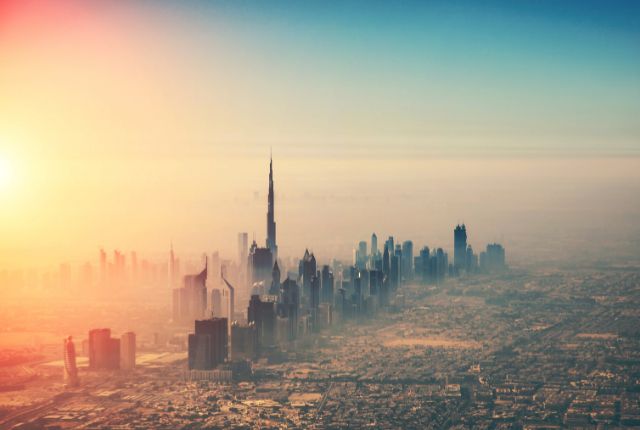Dubai, the dazzling jewel of the United Arab Emirates (UAE), has captured the world’s attention with its towering skyscrapers, luxurious lifestyle, and futuristic ambitions. But just how big is Dubai city? In this exploration, we delve into the dimensions of this dynamic metropolis, from its land area to its population, comparing it with other global cities along the way.
The Basics: Land Area and Geography
Dubai spans an area of approximately 35 square kilometers (35 km²). To put this into perspective, picture a space roughly equivalent to 4,375 football fields. Despite its modest size on the world map, Dubai packs a punch when it comes to economic influence, cultural richness, and architectural marvels.
Situated along the southeastern coast of the Arabian Peninsula, Dubai is perched at an elevation of about 16 meters, or 52 feet, above sea level. This modest elevation doesn’t diminish its grandeur; in fact, it provides a captivating juxtaposition to the city’s futuristic skyline.
A Thriving Population
As of 2022, Dubai boasts a population of around 3.60 million people, making it the most populous city in the UAE. This thriving metropolis has evolved from a modest trading port to a global hub for business, tourism, and innovation. The population diversity is a testament to Dubai’s inclusive and cosmopolitan ethos, with residents hailing from all corners of the globe.
Big or Small? Comparing Dubai’s Size
Is Dubai a Big or Small City?
Dubai, without a doubt, stands as a colossal city in the UAE. In fact, it is the largest city in the federation. Its impact extends beyond its physical size, with a global reputation for opulence and ambition. The city’s skyline, dominated by the iconic Burj Khalifa, reflects the towering aspirations that Dubai holds on the world stage.
But let’s not merely consider its geographical expanse; Dubai’s influence reaches far beyond its borders. Its economic significance, cultural contributions, and role as a global transportation hub make it a giant in its own right.
Dubai vs. Mumbai: A Tale of Two Cities
A natural question arises: How does Dubai compare to other major global cities, particularly Mumbai? Mumbai, the financial capital of India, covers an area of only 600 square kilometers. In a direct size comparison, Dubai’s land area of 35 km² seems dwarfed by Mumbai’s expanse.
However, numbers can be deceiving. Dubai’s impact far exceeds its land area, and this is evident when we look at the sheer scale of development and innovation packed into its limited space. While Mumbai sprawls across 600 square kilometers, Dubai’s 35 km² are densely packed with cutting-edge infrastructure, luxury residences, and world-renowned attractions.
Dubai vs. Karachi: A Regional Perspective
Expanding our comparative lens, let’s consider Karachi, the bustling metropolis of Pakistan. Karachi covers an area of approximately 3,500 square kilometers, dwarfing both Dubai and Mumbai in sheer size. Yet, Dubai’s prominence and global influence challenge the conventional notion that bigger is always better.
Dubai’s success story is a testament to strategic urban planning, visionary leadership, and an unwavering commitment to excellence. Despite its relatively compact size, Dubai has managed to position itself as a key player in the global arena.
Beyond the Numbers: Dubai’s Impact
Dubai’s significance extends beyond the quantitative metrics of size and population. It is a city that epitomizes innovation, resilience, and the pursuit of excellence. The audacious projects like the Palm Jumeirah, the Dubai Mall, and the Burj Khalifa are not just feats of engineering; they symbolize Dubai’s relentless pursuit of pushing boundaries and redefining possibilities.
Economic Powerhouse
Dubai’s economic prowess is evident in its status as a global business hub. The city’s strategic location, state-of-the-art infrastructure, and business-friendly policies have attracted multinational corporations, entrepreneurs, and investors from around the world. The Dubai International Financial Centre (DIFC) and the Dubai World Trade Centre are emblematic of the city’s commitment to fostering economic growth.
Tourism Magnet
Tourism is another dimension where Dubai outshines many cities. Beyond its glitzy skyscrapers, the city boasts a rich tapestry of cultural experiences, from the historic Al Fahidi District to the vibrant spice and gold souks. The annual influx of millions of tourists speaks volumes about Dubai’s allure as a global destination.
Innovation Hub
Dubai’s commitment to innovation is evident in projects like the Dubai Future Foundation and the Museum of the Future. These initiatives underscore the city’s determination to lead in emerging technologies and contribute to shaping the future.
Conclusion: Dubai’s Size Beyond the Surface
In conclusion, while Dubai may appear modest in terms of land area, its impact is immeasurable. The city’s journey from a humble trading post to a global powerhouse is a testament to its resilience, vision, and unwavering pursuit of excellence. As we ponder the question, “How big is Dubai city?” it becomes evident that Dubai’s size goes beyond the mere physical dimensions; it encompasses the enormity of its influence on the world stage.

